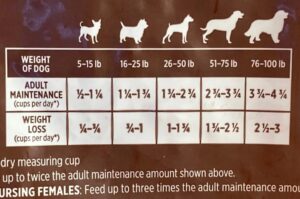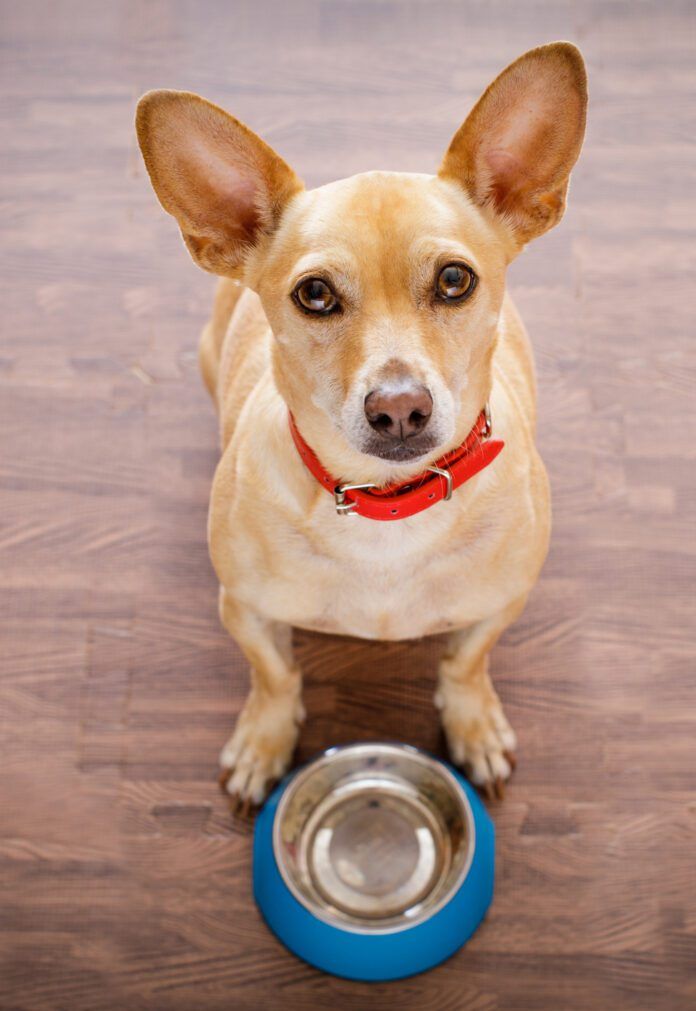How much to feed your dog depends on the dog’s size, age, genetics/breed, level of activity, and the food itself. Even whether the dog is spayed or neutered can make a difference in how much to feed your dog.
That’s why there are no official feeding guidelines for dogs. How much to feed your dog is a matter of calories, just as it is for us, and dogs vary widely on how many calories they need.
How Much to Feed a Dog by Weight
Calories in various brands of kibble range from less than 300 per cup to over 700 calories per cup, according to the American College of Veterinary Nutritionists. That’s a tremendous difference. Fortunately, most pet-food manufacturers now tell you how many calories are in a cup of their food.
As a rule of thumb, the number of calories your dog should be fed to maintain your dog’s ideal weight is referred to as the “resting energy requirement (RER).” To determine your dog’s RER, convert the dog’s ideal weight in pounds to kilograms by dividing by 2.2. Then multiply that number by 30 and add 70.
So, let’s say your dog’s ideal weight is 90 pounds.
- Ninety pounds divided by 2.2 is 40.9 kg.
- Now multiply by 30 and add 70: 40.9 x 30 = 1,227 + 70 = 1,297.
So, 1,297 is how many calories per day a 90-pound dog needs just to perform normal body functions (not additional exercise).
So, let’s say your dog’s ideal weight is 90 pounds. Ninety pounds divided by 2.2 is 40.9 kg. Now multiply by 30 and add 70: 40.9 x 30 = 1,227 + 70 = 1,297. So, 1,297 is how many calories per day a 90-pound dog needs just to perform normal body functions (not additional exercise).
Next, look at the food you’re feeding. Let’s say it contains 380 calories per cup. So, divide the number of calories (1,297) and divide that by 380, the number of calories in each cup of food: 1,297 ÷ 380 = 3.41 cups of food per day for an average 90-lb dog. But dogs aren’t all average, and every dog should receive at least some amount of exercise.
How Much Should Your Dog Eat
The University of Ohio Veterinary Medical Center says the RER must be multiplied by the dog’s energy needs and the RER then adjusted up or down to maintain a healthy weight. Individual dogs can vary widely from calculated values, so whatever figure you get still needs tweaking in order to reach and then maintain your dog’s healthy weight.
In order to lose weight, dogs who are obese should be fed at the RER for their ideal weight. Active, working dogs may need two to five times the RER to maintain weight. Average exercising neutered dogs need the RER x 1.6. Intact adult dogs with average work need RER x 1.8.
How to Tell if Your Dog is Overweight
If you can’t weigh your dog on a scale, at least run your hand over his body once a month. You should always be able to feel his ribs and, when you look down over his topline, you should see a waist at the end of the ribcage. If you can’t feel his ribs, your dog is too fat. A lower-calorie dog food might help some in these circumstances, but ultimately, reducing his daily portions will be needed.
“I tell my clients to take a hard, honest look at snacks and treats. Eliminate snacks and treats. For most dogs, I find that decreasing your dog’s meal portions by 25% is a simple, safe, effective approach to weight loss. If you’re training your dog and need treats for rewards, take some of the kibble he would get at mealtime and use that for treats,” says Eileen Fatcheric, DVM, in “Is My Dog Overweight?”

Measure: Use a standard measuring cup to measure your dog’s food. Use level measures – no heaping the food over the top of the cup!
Nutrients: Choose a food that is formulated to meet recommendations from American Association of Feed Control Officials (AAFCO). Most adult dogs do fine on a “maintenance” food. Puppies, moms, and hard-working dogs need more calories, protein, and fat. These dogs need a food made for “all life stages.”
Schedules: All dogs should be fed at least twice a day—at least three times a day for puppies—on as regular a schedule as possible. Never put a dog on free-choice food. Most dogs will eat it all in one sitting—or at least try to; but even those dogs who don’t gobble it up quickly should not be free-fed. It will take you a lot longer to notice if a dog has lost his appetite if you allow him to “graze” all day.
Scraps: Don’t mess up all your hard work by giving your dog table scraps, unless there’s a need (such as a picky eater, a senior dog, or a dog who is on boiled ground beef or chicken with rice due to an upset digestive tract) or unless you reduce his regular food portion accordingly. Added “leftovers” should never represent more than 25% of his daily caloric intake, or you risk unbalancing a “complete and balanced” diet.






Can you do an article about how much to feed when you’re using raw food diet. How many ounces of protein, versus actual bone, and is there a limit on low calorie, nutrient dense vegetables to add? Of course than adding all the organ meats and such… That counts into the overall ounces defeat, correct?
I agree with with @MicheleCayce! That info from a reliable source would be very helpful.
Me three. We use Steve’s frozen raw food patties. I’d like some guidance on the variety of foods to add to this diet and the calories.
Would I use the same formula for wet food as well as kibble? My dog eats a wet urinary food and some kibble. Thanks.
I have been feeding raw for 15 years to 2 dogs. I weigh all food and the two constants are half breakfast meat mix is green tripe. The rest of breakfast alternates different proteins beef, turkey, pork. The other constant is chicken necks for dinner. His weight is pretty well maintained.
The wrench in the works is the amount of treats used in our scentwork training.
We use a treat that Ms Kearns suggested, Nudges grillers. They are easily broken into small pieces and a “high value” treat. So caution is practiced.
My vet gave me some guidelines when both of my dogs got a little too “poofy.” First, I had them on a dog food for high energy and she said no, they’re not working dogs so I changed to the regular formula. I also cut back a bit as she said what was on the package was just a guideline. I need to feed them whatever keeps them at their ideal weight. So I started by cutting back 1/2 a cup at a time and eventually found the amount for their twice daily feedings to keep them at their ideal weight. But when I change dog foods I’ll need to start over again. I like to change every few years so they don’t develop allergies.
This may seem like a dumb question but how do I know what my dog’s ideal weight is? I need that to figure out my dog’s RER but he’s only 7 months and I don’t know if he’s reached his adult weight. Any suggestions?